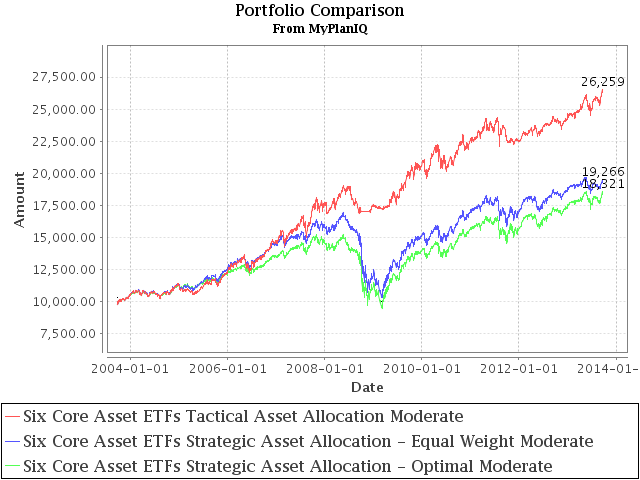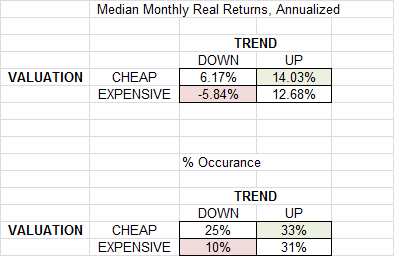Re-balance Cycle Reminder All MyPlanIQ’s newsletters are archived here.
For regular SAA and TAA portfolios, the next re-balance will be on next Monday, September 30, 2013. You can also find the re-balance calendar for 2013 on ‘Dashboard‘ page once you log in.
As a reminder to expert users: advanced portfolios are still re-balanced based on their original re-balance schedules and they are not the same as those used in Strategic and Tactical Asset Allocation (SAA and TAA) portfolios of a plan.
Please note that we now list the next re-balance date on every portfolio page.
Late Stage Momentum?
As Federal Reserve put off the Tapering talk, stocks reacted with another surge that since have gradually retracted. However, we do notice that other sectors such as emerging market stocks and global and US REITs have recovered more strongly. As the relentless ascent of U.S. stocks and now international stocks throughout the year, we think it is a good time to review some of these momentum based portfolios and discuss what’s ahead.
Momentum based portfolios at different granularity levels
We did some comprehensive discussion on this topic in April 1, 2013: Momentum Over Stocks, Sector And Style Funds. In the newsletter, we categorized momentum based investing at different granularity levels ranging from individual stocks to major asset classes. We made the following observation:
Based on the above discussions, we make the following assessment:
- m1: A group of individual stocks such as Dow Jones 30 or Nasdaq 100 etc. — Can be Effective, but volatile.
- m2: A group of industrial stock funds such as Fidelity’s famous Fidelity Select funds. – Can be Effective, but volatile.
- m3: A group of stock sector funds such as SPDR’s S&P sector ETFs such as SPDR Select Energy (XLE) etc. – Can be Effective, but volatile.
- m4: A group of stock style funds such as Russell large, mid and small cap stock ETFs. – Effective and comparable risk.
- m5: single stock index (fund) buy/sell decision. – Fickle though might be on par with buy and hold.
- m6: A group of diversified and somewhat uncorrelated asset classes such as stocks, bonds, real estates (REITs) and their minor asset classes such as long term bonds, international bonds, gold etc. – Effective and lower risk.
Let’s look at the comparison tables again using the latest performance info:
m1: Individual stock portfolio performance comparison (as of 9/20/2013)
| Ticker/Portfolio Name | YTD Return** |
1Yr AR | 3Yr AR | 3Yr Sharpe | 5Yr AR | 5Yr Sharpe | 10Yr AR |
|---|---|---|---|---|---|---|---|
| PIE (PowerShares DWA Em Mkts Technical Ldrs) | 1.7% | 9.6% | 4.3% | 0.18 | 5.2% | 0.16 | |
| EEM (iShares MSCI Emerging Markets Index) | -3.9% | 2.9% | 0.7% | 0.03 | 3.8% | 0.09 | 11.7% |
| AMOMX (AQR Momentum L) | 23.7% | 21.8% | 16.3% | 0.87 | |||
| PDP (PowerShares DWA Technical Leaders) | 22.1% | 23.9% | 18.5% | 0.96 | 9.9% | 0.36 | |
| SPY (SPDR S&P 500) | 21.0% | 19.0% | 16.6% | 0.99 | 8.8% | 0.35 | 7.2% |
| AIMOX (AQR International Momentum L) | 17.0% | 22.2% | 9.3% | 0.46 | |||
| EFA (iShares MSCI EAFE Index) | 15.3% | 21.6% | 9.0% | 0.4 | 4.0% | 0.13 | 7.2% |
| ASMOX (AQR Small Cap Momentum L) | 31.9% | 32.6% | 21.6% | 0.88 | |||
| IWM (iShares Russell 2000 Index) | 27.3% | 27.6% | 18.6% | 0.81 | 9.0% | 0.28 | 8.8% |
**YTD: Year to Date, NOT annualized
More detailed year by year comparison >>
The table is arranged in a way so that funds in a category are compared against their benchmarks. One can see that for the last one year, all of momentum based funds have outperformed their benchmarks. However, one should not forget that these funds lagged (some were seriously) behind their benchmarks if one looked at these in early 2012 or 2011. Furthermore, they are more volatile.
m2-m3: Sector momentum portfolio performance comparison (as of 9/20/2013):
| Ticker/Portfolio Name | YTD Return** |
1Yr AR | 3Yr AR | 3Yr Sharpe | 5Yr AR | 5Yr Sharpe | 10Yr AR | 10Yr Sharpe |
|---|---|---|---|---|---|---|---|---|
| P Momentum Scoring Sector ETFs | 17.6% | 15.5% | 12.5% | 0.74 | 4.4% | 0.2 | 9.3% | 0.41 |
| SPY (SPDR S&P 500) | 21.0% | 19.0% | 16.6% | 0.99 | 8.8% | 0.35 | 7.2% | 0.3 |
In this case, the P Momentum Scoring Sector ETFs that rotates among S&P sectors has under performed against S&P 500 for the past 1, 3 and 5 years. Though it has bettered for the 10 year period. This indicates the nature of inconsistent performance .
m4: Style rotation portfolio performance comparison (as of 9/20/2013):
| Ticker/Portfolio Name | YTD Return** |
1Yr AR | 3Yr AR | 3Yr Sharpe | 5Yr AR | 5Yr Sharpe | 10Yr AR | 10Yr Sharpe |
|---|---|---|---|---|---|---|---|---|
| P Momentum Scoring Style ETFs | 27.7% | 28.3% | 19.2% | 1.03 | 8.9% | 0.32 | 8.4% | 0.32 |
| SPY (SPDR S&P 500) | 21.0% | 19.0% | 16.6% | 0.99 | 8.8% | 0.35 | 7.2% | 0.3 |
As indicated, the style rotation strategy is more consistent, outperforming its benchmark in all 1, 3, 5, 10 year periods.
Finally, for m6, tactical asset allocation among major asset classes:
Portfolio Performance Comparison (as of 9/23/2013)
| Ticker/Portfolio Name | YTD Return** |
1Yr AR | 3Yr AR | 3Yr Sharpe | 5Yr AR | 5Yr Sharpe | 10Yr AR | 10Yr Sharpe |
|---|---|---|---|---|---|---|---|---|
| Six Core Asset ETFs Strategic Asset Allocation – Equal Weight Moderate | 3.1% | 3.9% | 6.5% | 0.62 | 5.3% | 0.32 | 6.8% | 0.43 |
| Six Core Asset ETFs Strategic Asset Allocation – Optimal Moderate | 5.4% | 6.4% | 7.7% | 0.72 | 6.5% | 0.39 | 6.2% | 0.39 |
| Six Core Asset ETFs Tactical Asset Allocation Moderate | 7.8% | 8.2% | 7.0% | 0.85 | 8.7% | 0.85 | 10.1% | 0.84 |
One can see that the TAA portfolio has outperformed the equal weight portfolio for 1, 3, 5 and 10 year periods. Even though this portfolio lags behind the US centric 60% stock and 40% bond portfolio, we contend that it is only fair to compare against a global diversified portfolio.
What the above tells us is that momentum has outperformed buy and hold benchmarks in this year, mostly due to persistent US stocks and international stocks strength, which resulted in some noticeable trends.
Momentum in overvalued and overbought markets
However, we caution that all is not too well, given the currently weak fundamentals. The following data from Mebane Faber and/or John Hussman should keep our feet on the ground:
In the above table, valuation is measured using Shiller’s Cyclically Adjusted PE 10 (CAPE10) as the metric (CAPE 10 is the average 10 year price earnings ratios). When CAPE10 vs. its long term average is bigger than 1.17, market is said to be overvalued, otherwise, it is classified as under valued. Trend is just using 10 month moving average.
What the above tells us? Currently, CAPIE10 is about 1.52, way overvalued. Trend following strategy can lose money when the up trend breaks down.
Outlook: Untappered QE, looming government shutdown and seasonality
Putting all these together, we are at an interesting cross road (well, when weren’t we at an uninteresting and boring time lately?):
- The latest Fed’s untappered decision (i.e. leaving the existing QE unchanged) started a speculative frenzy. Though the frenzy has died down a bit, it might again strengthen, especially in the improved economic news coming from Europe and China.
- This possible speculative blowoff (as John Hussman put it) bodes well with the coming year end seasonality. Though September is traditionally the weakness month for stock markets, other news might override it.
- However, the looming possible government shutdown in the U.S. might again wreak havoc this party.
To summarize, we are see many forces are at work for and against each other: on one hand, markets can go irrational for a long period of time until the bubble pops. On the other hand, fundamentals and valuation are not on the investors’ side. The best way for investors to do is to stay on course at a proper risk level they feel comfortable.
Portfolio Performance Review
We review our TAA portfolios with several tactical funds that we believe are relevant:
| Ticker/Portfolio Name | YTD Return** |
1Yr AR | 3Yr AR | 3Yr Sharpe | 5Yr AR | 5Yr Sharpe | 10Yr AR |
|---|---|---|---|---|---|---|---|
| MyPlanIQ Diversified Core Allocation ETF Plan Tactical Asset Allocation Growth | 9.8% | 12.3% | 8.4% | 0.78 | 10.4% | 0.75 | 13.0% |
| Retirement Income ETFs Tactical Asset Allocation Moderate | 5.2% | 7.4% | 8.7% | 1.05 | 9.7% | 0.92 | 10.6% |
| DWTFX (Arrow DWA Tactical A) | 16.6% | 15.6% | 8.0% | 0.58 | 4.8% | 0.26 | |
| GTAA (Cambria Global Tactical ETF) | -0.7% | 0.3% | |||||
| GDAFX (Goldman Sachs Dynamic Allocation A) | 1.7% | 1.0% | 3.8% | 0.51 |
More detailed portfolio info >>.
Arrow DWA Tactical DWTFX has done the best. However, both GTAA and GDAFX have been overly conservative, under performing our portfolios.
Market Overview
Markets gave back most of gains since the Fed’s untappered announcement. However, the strength of risk assets are still noticeably strong for now.
For more detailed asset class trends, see 360° Market Overview.
We again copy our position statements (from previous newsletters):
Our position has not changed: We still maintain our cautious attitude to the recent stock market strength. Again, we have not seen any meaningful or substantial structural change in the U.S., European and emerging market economies. However, we will let markets sort this out and will try to take advantage over its irrational behavior if it is possible.
We again would like to stress for any new investor and new money, the best way to step into this kind of markets is through dollar cost average (DCA), i.e. invest and/or follow a model portfolio in several phases (such as 2 or 3 months) instead of the whole sum at one shot.
Latest Articles
- World -July & August 2013 Returns
- 10 Best Large Value Mutual Funds — Equity Income Funds Shine
- Wasik Nano
- Tail Risk
- The Beginning of the End for Skyrocketing College Costs?
- Equal Weight Is Back: S&P 500 Equal Weight Outrunning S&P 500 Again
- From the Archives: Mebane Faber’s New White Paper on Relative Strength
- Is The Optimum Level Of Annuity Ownership Negative?
- Five investment lessons from the Lehman Brothers blow-up
- September 16, 2013: Fixed Income No More?
Enjoy Newsletter
How can we improve this newsletter? Please take our survey
–Thanks to those who have already contributed — we appreciate it.




 Diversified Asset Allocation Portfolios For Your Plans
Diversified Asset Allocation Portfolios For Your Plans
